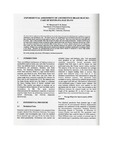| dc.contributor.author | Mmusi, M. | |
| dc.contributor.author | Batane, N.R. | |
| dc.date.accessioned | 2013-08-09T12:37:01Z | |
| dc.date.available | 2013-08-09T12:37:01Z | |
| dc.date.issued | 2011 | |
| dc.identifier.citation | Mmusi, M. & Batane, N.R. (2011) Experimental assessment of locomotive brake blocks-case of Botswana Railways; Botswana Journal of Technology, Vol. 19, No. 2, pp.142. | en_US |
| dc.identifier.issn | 1019 1593 | |
| dc.identifier.uri | http://hdl.handle.net/10311/1166 | |
| dc.description.abstract | The brake blocks employed on Botswana Railways locomotives have been found to fail frequently resulting in increased maintenance and operational costs. The paper presents the metallurgical and mechanical properties of two different types of brake blocks (referred to in this paper as "Type A" and "Type B”). These have been observed to fail differently in service. Type A fails normally while Type B fails at a faster rate and usually prematurely. Analysis carried out on the brake blocks materials include mechanical testing, optical microscopy and electron dispersion spectroscopy (EDS). The elemental compositions of the materials differ among others, in: carbon, sulphur, phosphorus and manganese. EDS results show that elemental composition of the materials influences the behaviour of the material under loading conditions. Finally, it was concluded that porosity content in the materials contributes significantly to premature failure of the blocks. Therefore the manufacturing process of brake blocks should be monitored to ensure high quality products and enhanced service life of the brake blocks. | en_US |
| dc.language.iso | en | en_US |
| dc.publisher | University of Botswana, www.ub.bw | en_US |
| dc.subject | Porosity | en_US |
| dc.subject | Rate of water | en_US |
| dc.subject | EDS analysis | en_US |
| dc.subject | Mechanical properties | en_US |
| dc.title | Experimental assessment of locomotive brake blocks-case studies of Botswana Railways | en_US |
| dc.type | Published Article | en_US |

